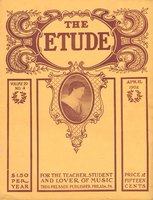Among the latest inventions of this panoramic and progressive age, one, we are told, will deeply interest all fiddle-lovers. This invention is in the form of a new violin, hot from the workshop of Mr. Stroh. We say advisedly, “in the form of a new violin,” because, in the description given us of Mr. Stroh’s new instrument, we are chiefly impressed with the fact that he has resolved to revolutionize all our ideas as to the physical beauty and scientific accuracy of the violin bequeathed to us by the immortal Stradivari.
Mr. Stroh’s new violin is described as follows:
“The instrument is shorn of back, sides, and belly, as found in the ordinary violin, leaving the scroll, finger-board, bridge, strings, and bass-bar for the fiddler to fiddle on. The bridge rests upon an oscillating lever, the vibrations of which are communicated, by means of a small connecting-link, with a corrugated aluminum disc acting as a vibrating diaphragm. This contrivance is connected with a metal trumpet or resonator, in appearance similar with that used on a phonograph. The front view of the instrument, in the hands of a performer, resembles a skeleton practice-fiddle attached to a bell-front alto. It is altogether strikingly peculiar in appearance, but everyone will forgive that if the claims made for it otherwise can be substantiated.”
Among Mr. Stroh’s various claims of the superiority of the new violin over the old, the one that has startled us, and certainly seems most worthy of mention, is its prodigious tone. Mr. Stroh assures us that, in volume of tone, two of his new fiddles and one viola are fully the equal of eight or nine fiddles of the conventional form.
If Mr. Straw, or Stroh—it amounts to the same thing—is really in earnest, one of the gravest problems which have heretofore confronted the infant violinist has been solved. The puniest child of three years or less can, with a Stroh fiddle, overwhelm a small orchestra at Carnegie Hall by merely aiming his resonator at the audience.
But why not two aluminum discs and two resonators? We fear that Mr. Stroh has missed a golden opportunity. He has evidently failed to perceive the great possibilities of economy which his invention suggests to the prosaic individual. If, equipped with only one resonator and one aluminum disc, each of his fiddles has a capacity of tone equal to that of about three fiddles of stereotyped structure, there is some reason for hoping that two such discs and resonators, properly attached to a “skeleton” fiddle, would have the result of enabling one player to produce a volume of tone equal to the combined efforts of five or six players of ordinary instruments. Think of the possibilities! On such a basis of calculation, it will henceforth be possible, with only two players, to achieve the results hitherto attained in the orchestra by at least ten or twelve fiddlers. Here is something for Mr. Stroh to think about; and we hope that he will see his way clear to add a few more resonators to his contrivance.



